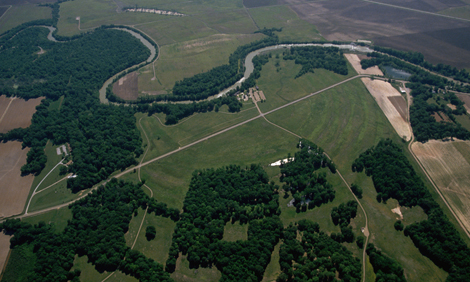


This aerial photo shows the ruins of an ancient village at Poverty Point, Louisiana.
In January, the ancient Native American ruins at Poverty Point, Louisiana, were nominated to become a UNESCO World Heritage Site. UNESCO is a division of the United Nations that decides which sites around the world are of outstanding physical or cultural importance. The Grand Canyon and the Statue of Liberty are examples of UNESCO World Heritage Sites in the United States.
Hunter-gatherers built the settlement at Poverty Point between about 1700 B.C. and 1300 B.C. There, they created a series of earthworks made up of large earthen mounds and ridges. Scientists think that the ancient people of Poverty Point may have used the mounds for religious ceremonies. The ridges probably served as areas for homes or shelters.
For scientists, Poverty Point has long been a place of mysteries. For example, it is very unusual that a community of hunter-gatherers built large earthworks. It is more typical to find earthworks among the ruins of farming communities. Scientists have been equally puzzled about how the hunter-gatherers at Poverty Point were able to build such large earthworks. During its time, the Poverty Point settlement had the largest earthworks in the Western Hemisphere.
In February, scientists announced new discoveries about how the people of Poverty Point may have built the earthworks. After studying soil samples, the scientists concluded that about 3,000 workers probably built the largest of the mounds in fewer than 90 days. The workers likely did this by forming a human chain and passing 50-pound baskets of dirt from person to person. This task would have been equal to a large dump truck moving more than 30,000 loads of dirt!
Today, Poverty Point is managed by the state of Louisiana. It is open to the public and includes a visitor center, museum, and research laboratory. Visitors can take guided tours of the site and see the ancient ruins firsthand.
Image credit: ©Richard A. Cooke/Corbis
Related Links
- Poverty Point National Monument
Learn more about Poverty Point and the ancient people who once lived there. - Poverty Point State Historic Site
Read more about the mounds at Poverty Point and how they were built.



























